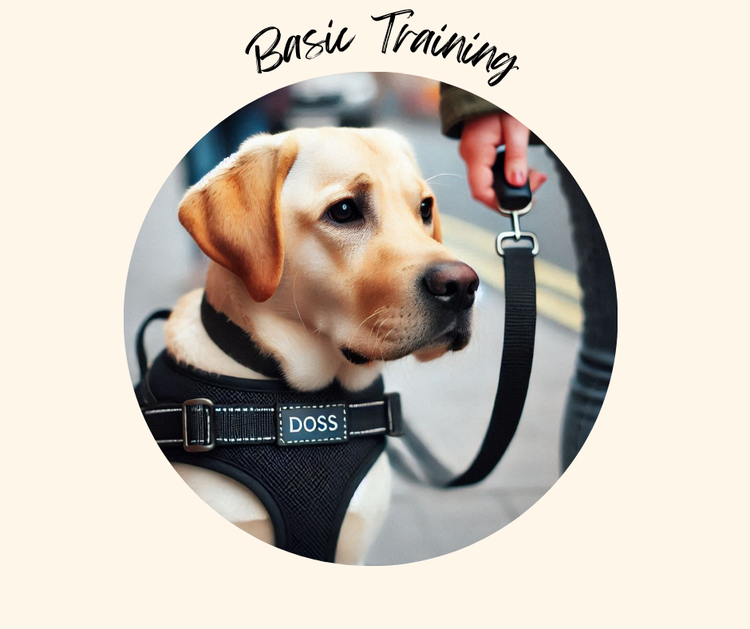Collection: Harnes & Leads
Harnesses and dog leads (or leashes) are essential tools for walking and controlling your dog. Here's a breakdown of both:
Dog Harness:
A harness is worn around a dog’s chest, back, or neck, distributing pressure evenly across the body instead of putting strain on the neck (as collars do). It's often recommended for dogs that pull, have respiratory issues, or are prone to neck injuries.
Types of Dog Harnesses:
- Back Clip Harness: The leash attaches to the back of the harness. It’s comfortable for most dogs and good for casual walks.
- Front Clip Harness: The leash attaches to the front of the harness, which helps discourage pulling and gives you more control over your dog’s movements.
- Dual Clip Harness: Has both front and back clips for maximum versatility, often used for training and walking.
- Step-in Harness: The dog steps into the harness, and then it's clipped together on the back. These are often easy to put on.
- Vest Harness: Covers a larger portion of the dog's chest and back for better comfort and support. It’s great for small dogs or dogs that need extra security.
Dog Leads (Leashes):
A lead is a leash that attaches to the harness or collar and allows you to control your dog while out walking.
Types of Dog Leads:
- Standard Leash: Typically around 4 to 6 feet long, ideal for regular walks.
- Retractable Leash: Allows you to adjust the length of the leash, giving your dog more freedom to roam but still maintain control.
- Training Leash: Usually longer (15-30 feet) and used for training purposes, allowing more space for your dog to explore while still keeping them under control.
- Adjustable Leash: These leashes can be lengthened or shortened depending on your needs, providing flexibility in different situations.
- Hands-Free Leash: Designed for runners or cyclists, it can be worn around the waist or attached to a belt.
Choosing the Right Set for Your Dog:
- Size and Breed: Consider the dog's size, strength, and walking habits. Smaller dogs may need a lighter, more comfortable harness, while stronger dogs may need a sturdier harness and leash.
- Walking Style: If your dog pulls a lot, a front clip harness with a shorter lead can help with control.
- Training Needs: For training, a long leash can be beneficial to give your dog space while maintaining control.
Do you have a specific type of dog or breed in mind? That might help narrow down which harness and lead would be best for your dog!

-
P Shape Slip Training Lead 136 cm long soft & Durable
Regular price $18.00 AUDRegular priceUnit price / per$25.00 AUDSale price $18.00 AUDSale -
Dog Lead Strong Rock Climbing Material P Shape Green
Regular price $35.00 AUDRegular priceUnit price / per$35.00 AUDSale price $35.00 AUD -
Dog Lead Strong Rock Climbing Material P Shape Red
Regular price $35.00 AUDRegular priceUnit price / per$35.00 AUDSale price $35.00 AUD -
Dog Harness Strong Nylon Reflective Easy clip on Custom Name
Regular price $34.99 AUDRegular priceUnit price / per$22.00 AUDSale price $34.99 AUD -
Dog Lead Dual Handle Black Black Red
Regular price $20.00 AUDRegular priceUnit price / per$35.00 AUDSale price $20.00 AUDSale -
Dual Purpose Harness Rain Coat
Regular price $40.00 AUDRegular priceUnit price / per$60.00 AUDSale price $40.00 AUDSale -
Dog Lead Dual Handle Blue
Regular price $20.00 AUDRegular priceUnit price / per$35.00 AUDSale price $20.00 AUDSale -
Dog Lead Dual Handle Black Green
Regular price $20.00 AUDRegular priceUnit price / per$35.00 AUDSale price $20.00 AUDSale -
Dog Lead Dual Handle Black Blue
Regular price $20.00 AUDRegular priceUnit price / per$35.00 AUDSale price $20.00 AUDSale -
Dog Lead Dual Handle Black
Regular price $20.00 AUDRegular priceUnit price / per$35.00 AUDSale price $20.00 AUDSale -
Dog Harness Strong Nylon Reflective Easy clip on Orange
Regular price $15.00 AUDRegular priceUnit price / per$22.00 AUDSale price $15.00 AUDSale -
Dog Harness Strong Nylon Reflective Easy clip on Black
Regular price $15.00 AUDRegular priceUnit price / per$22.00 AUDSale price $15.00 AUDSale -
Cool Harness for Dogs Coat pastel blue
Regular price $37.00 AUDRegular priceUnit price / per$45.00 AUDSale price $37.00 AUDSale -
Cool Harness Coat for Dogs (Pink)
Regular price $37.00 AUDRegular priceUnit price / per$45.00 AUDSale price $37.00 AUDSale














